In 2024, the European Safety Gate rapid alert system issued over 4000 notifications to protect consumers across the EU. Created in 2001, the system aims to prevent potentially harmful non-food products (except pharmaceuticals) from being placed on the market. Threats include the risk of choking, hearing or visual damage, and chemical hazards. The system is available 24 hours a day and enables the authorities of member countries to exchange information on harmful products found in their national markets. According to the European Commission, the number of alerts has significantly increased in recent years, reflecting the efforts made by all surveillance authorities to guarantee consumers’ safety and enforce legislation.
Most of the issued alerts in 2024 concern cosmetic products: 36% in Europe and even 79% in Luxembourg. 97% of alerts on cosmetics involve a chemical risk due to the presence of BHMCA (butylphenyl methylpropional, or Lilial), a synthetic fragrance used in several beauty products. The fragrance was banned from the EU market in 2022 because it can damage the reproductive system and cause skin irritation. After cosmetics, the products presenting the greatest health risks in Europe are toys (15%), electrical appliances (10%), and motor vehicles (9%). In Luxembourg, motor vehicles present the greatest risk (11%), after cosmetics. These products may also present a chemical risk due to the presence of substances like lead or chlorinated paraffin.
Since the end of 2024, the European legislation on general product safety has been extended to online shopping, requiring that all products sold on the web must be safe, regardless of origin. More recently, an agreement has been reached to enhance toys’ safety, creating a digital passport to prevent dangerous toys from being sold in the EU.
Luxembourg: most alerts on high-risk products concern cosmetics
Type of event:
Chemical risk, Product safety
April 27, 2025


